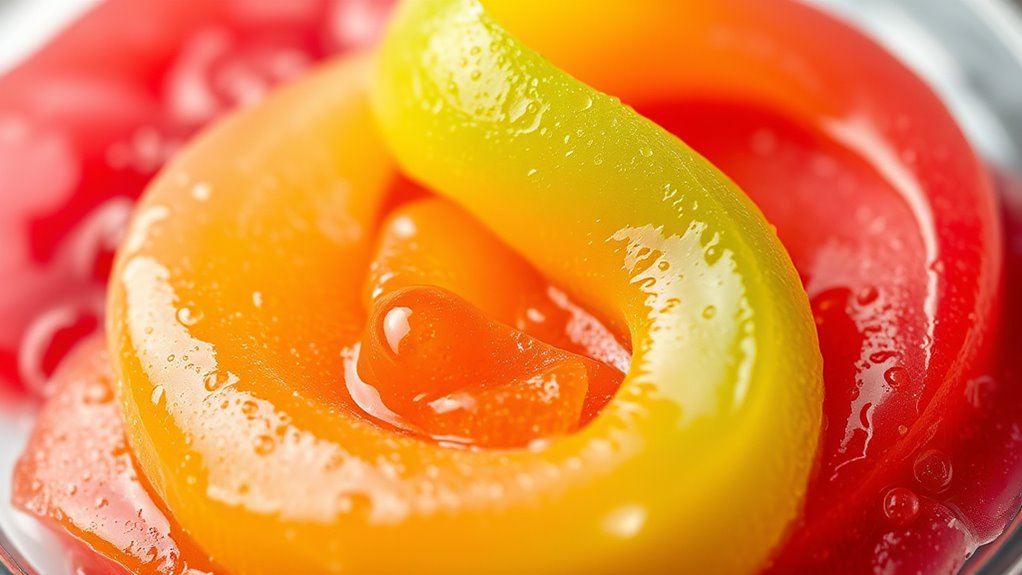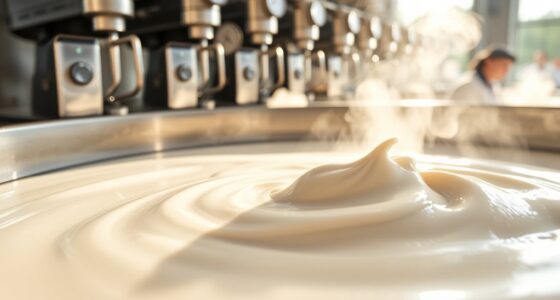To stabilize sorbets and swirls, it’s essential to balance fruit acids and pectin properly. Acids lower the pH, strengthening the gel network that keeps textures smooth and prevents large ice crystals, while also enhancing flavor. Adjusting the acids ensures your dessert isn’t too soft or rubbery. When you fine-tune this balance, your frozen treats stay firm, vibrant, and inviting. Keep exploring how pH control can refine your dessert’s consistency and appeal.
Key Takeaways
- Fruit acids lower pH, enhancing pectin gel formation and stabilizing the structure of sorbets and swirls.
- Maintaining an optimal pH (3.0–3.5) ensures strong pectin networks, preventing melting and ice crystal growth.
- Proper acid levels help stabilize swirls, keeping them distinct and preventing blending during freezing.
- Adjusting fruit acids fine-tunes acidity, balancing flavor and gel strength for desirable textures.
- Monitoring pH with meters or strips is essential for consistent stabilization of frozen desserts.

Fruit acids and pectin are essential components that influence the flavor, texture, and quality of many fruits and their products. When you’re working with sorbets and swirls, understanding how these elements interact can make a significant difference in achieving the perfect consistency and stability. A key factor here is pH balance. Fruit acids naturally lower the pH of your mixture, creating an environment that not only enhances flavor but also promotes gel formation. When the pH is just right, pectin molecules can effectively connect, forming a network that gives your sorbet a smooth, cohesive texture without being too icy or runny.
Fruit acids and pectin are key to perfect, stable sorbets and swirls.
Maintaining the right pH balance is vital because pectin’s gelling ability depends heavily on acidity. If your mixture is too alkaline, pectin won’t gel properly, resulting in a watery or overly soft texture. Conversely, if it’s too acidic, the gel might become too firm or rubbery. Typically, fruit acids such as citric, malic, or tartaric acid help you fine-tune this pH level. By adjusting the acidity, you guarantee that pectin can form a stable gel matrix, which is essential for creating well-structured sorbets and swirls. This gel formation traps air and water molecules, giving your frozen treats a desirable consistency, preventing them from melting too quickly or turning icy.
When you’re stabilizing sorbets and swirls, think of pH as the key to releasing pectin’s full potential. Adding the right amount of acid not only enhances the fruit flavor but also helps the pectin set properly. It’s a delicate balance—you want enough acidity to promote gel formation, but not so much that it adversely affects taste or texture. As you mix your ingredients, test the pH with a simple meter or strips to guarantee you’re within the optimum range, usually between 3.0 and 3.5 for most fruit-based gels.
Additionally, understanding how AI technology can help optimize formulations may lead to more consistent results over time. Furthermore, the presence of fruit acids can influence how the gel behaves during freezing. A well-balanced pH guarantees that the gel network remains flexible enough to prevent the formation of large ice crystals, which can ruin the smooth mouthfeel of your sorbet. It also helps stabilize swirls, making sure they hold their shape and don’t blend into the surrounding ice. By understanding the relationship between pH balance and gel formation, you gain control over the final product’s texture, making your frozen desserts irresistibly smooth, firm, and delicious.
Frequently Asked Questions
Can Fruit Acids Replace Traditional Stabilizers Entirely?
No, fruit acids can’t fully replace traditional stabilizers, but they do play a crucial role in your recipes. They act as natural preservatives, extending shelf life, and enhance flavor by balancing sweetness and tartness. While fruit acids help stabilize sorbets and swirls, combining them with pectin or other stabilizers ensures better texture and consistency. Use them together for a healthier, flavorful treat that appeals to health-conscious consumers.
How Does Pectin Affect Sorbet Shelf Life?
Pectin notably extends your sorbet’s shelf life through fruit acid interactions that promote gelation, creating a stable structure. When pectin forms a gel, it helps prevent ice crystal growth and structural breakdown over time. By controlling pectin levels and ensuring proper fruit acid interactions, you can improve sorbet stability, maintain texture, and prolong freshness, making your frozen treats more resilient during storage.
Are Some Fruits Better for Natural Stabilizers Than Others?
Think of fruit selection as choosing the best actors for a play—you want natural stabilizers to shine. Some fruits, like berries and citrus, are better choices because their ripeness level enhances natural pectin and acidity, helping stabilize sorbets and swirls. Ripe fruits release more pectin and flavor, making your frozen treats smoother and longer-lasting. So, pick fruits that are ripe but not overripe for ideal natural stabilization.
What Is the Optimal Ph Range for Fruit Acids?
You should aim for a pH range of about 2.8 to 3.3 for fruit acids, as this guarantees ideal acid strength and pH balance. Maintaining this range helps stabilize your sorbets and swirls while preserving flavor. Too low pH can make the mixture overly tart, while too high may reduce effectiveness. Adjust your fruit selection or add acid accordingly to stay within this perfect pH window for perfect results.
Can Combining Fruit Acids and Pectin Improve Texture?
Combining fruit acids and pectin can indeed improve texture and enhance flavor. The acids help break down pectin’s structure, allowing for better texture modification, making sorbets and swirls smoother and more stable. This synergy also boosts flavor, as acids brighten and intensify fruit notes. You’ll notice a more refined, appealing mouthfeel while enjoying the added flavor depth, making your frozen desserts more delicious and satisfying.
Conclusion
Just like the steady hand of Da Vinci’s brush, fruit acids and pectin work together to keep your sorbets and swirls perfectly stable. Remember, they’re the unsung heroes behind the scenes, much like the secret ingredients that make a masterpiece. By understanding their role, you can craft desserts that not only delight the palate but also stand the test of time—true culinary artistry in every scoop.










